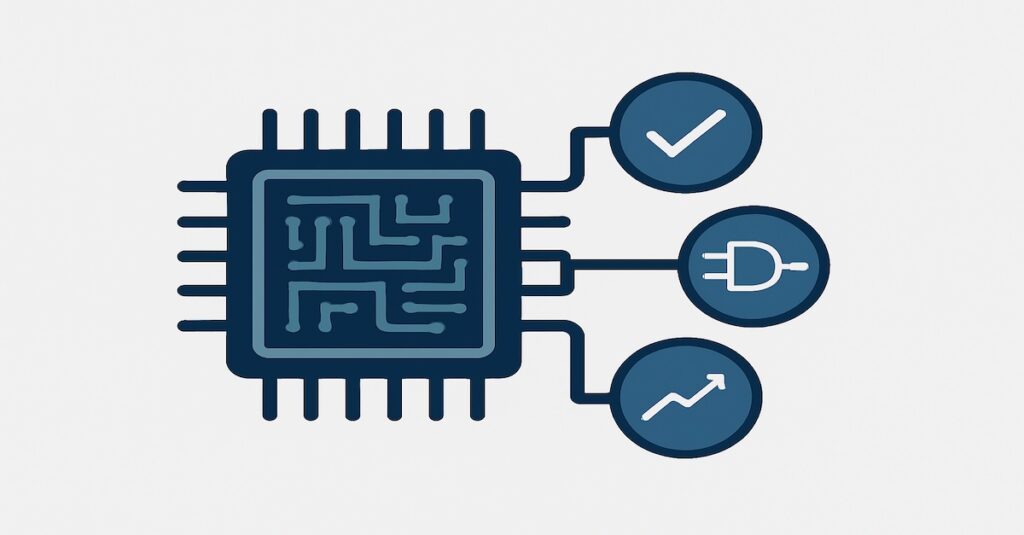Image Generated Using DALL-E
Post-Tape Out Validation Types
The post-silicon tape-out phase in semiconductor product development involves rigorous testing to ensure that the manufactured devices meet their intended specifications and perform reliably in real-world applications. This phase is critical because it represents the first opportunity to evaluate the physical samples of the semiconductor devices.
While ATE-based testing is the most widely known way to validate a silicon chip, board-specific validation types are also crucial in ensuring the device meets all the specifications.
Bench Validation: Bench validation involves direct electrical testing of the semiconductor devices on a workbench setup. This type of testing requires characterization using lab equipment like oscilloscopes, multimeters, and signal generators to measure the electrical properties of the devices, such as current, voltage, and frequency.
Application Validation: Focuses on evaluating how well the semiconductor devices perform in specific application scenarios or end-use conditions. They integrate the devices into a representative or actual system and test them under real or simulated operational conditions.
Firmware Validation: As semiconductor devices become more complex and programmable, firmware validation has become an integral part of the post-tape-out validation process. It includes verifying that the firmware is bug-free, functions as intended across various hardware configurations, and interacts correctly with other system components.
System Validation: Takes a holistic approach, assessing the semiconductor device’s performance within the context of the complete system. This type of validation ensures that the device meets its individual specifications and performs well when integrated with other system components.
Each post-tape-out validation activity — bench, application, firmware, and system validation — is crucial for ensuring that semiconductor devices will perform reliably and efficiently in their intended applications.
The insights gained from these tests, guide engineers in making necessary adjustments and improvements, ultimately producing high-quality, reliable semiconductor products.

Skills And Responsibilities
The skills and responsibilities associated with each type of post-tape validation activity highlight the interdisciplinary nature of the semiconductor validation field. Engineers must deeply understand electrical engineering principles, software development, system architecture, and application-specific requirements.
Moreover, their roles demand technical proficiency and the ability to collaborate across teams, communicate effectively, and manage complex validation projects. As the semiconductor industry continues to advance, the importance of these professionals will only grow.
They play a pivotal role in bridging the gap between design and real-world application, ensuring that innovations in semiconductor technology translate into reliable, high-performing products that meet the evolving needs of consumers and industries alike.
Some of the skills and responsibilities of validation engineers are stated below:
| Validation | Key Skills | Responsibilities |
|---|---|---|
| Bench | – Electrical engineering fundamentals | – Conducting electrical measurements (voltage, current, frequency) using lab equipment (oscilloscopes, multimeters) and characterization |
| – Proficiency with lab equipment | – Analyzing test data to identify deviations from expected performance | |
| – Attention to detail | – Debugging and troubleshooting device issues at the electrical level | |
| – Data analysis and interpretation | – Documenting test results and providing feedback to design teams | |
| Application | – Understanding of application-specific requirements | – Integrating semiconductor devices into application-specific systems or test platforms |
| – System design and integration skills | – Simulating real-world operating conditions to validate device performance | |
| – Problem-solving skills | – Identifying and resolving compatibility and performance issues in specific applications | |
| – Communication and collaboration skills | – Collaborating with cross-functional teams to ensure device meets application requirements | |
| Firmware | – Programming and scripting (e.g., C/C++, Python) | – Writing and executing test scripts to validate firmware functionality across different hardware configurations |
| – Understanding of embedded systems and microcontroller architectures | – Identifying and debugging firmware issues, including compatibility, stability, and performance problems | |
| – Software testing methodologies | – Ensuring firmware updates and patches do not introduce new issues | |
| – Attention to detail | – Documenting firmware validation processes and results | |
| System | – Broad technical knowledge of system architecture and components | – Testing the integration of semiconductor devices within the overall system to ensure compatibility and performance |
| – System Architecture Knowledge | – Understanding of various system architectures, including how different components (processors, memory, I/O devices) interact within a system. | |
| – Analytical and problem-solving skills | – Collaborating with system engineers, designers, and quality assurance teams to address and resolve issues | |
| – Security fundamentals | – Understanding of security principles and practices, especially for devices that will operate in secure or sensitive environments. |
Take Away
For students aspiring to enter the dynamic field of semiconductor validation, understanding the diversity of skills and responsibilities required across different post-tape activities is crucial. It is not just about mastering the technical aspects of electrical engineering, programming, or system design. It is also about developing solid problem-solving abilities, working collaboratively in multidisciplinary teams, and honing your communication skills.
This field offers a unique opportunity to contribute to the cutting edge of technology, where your work ensures that the semiconductor devices powering tomorrow’s innovations are reliable, efficient, and meet the highest quality standards. Whether your interest lies in bench testing, application testing, firmware validation, or system validation, the semiconductor industry provides a challenging and rewarding career path that plays a pivotal role in shaping the future of technology.






